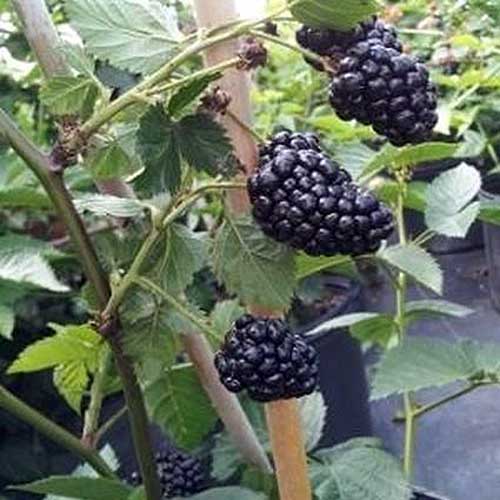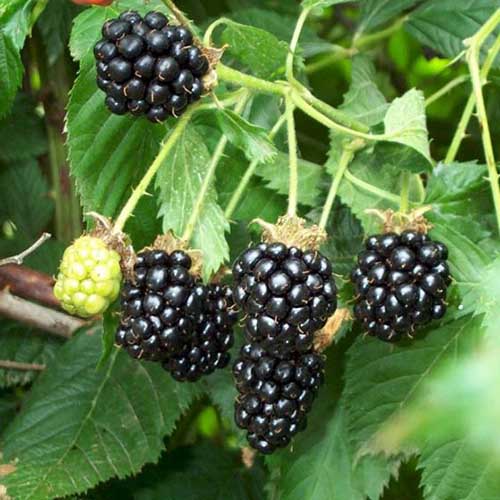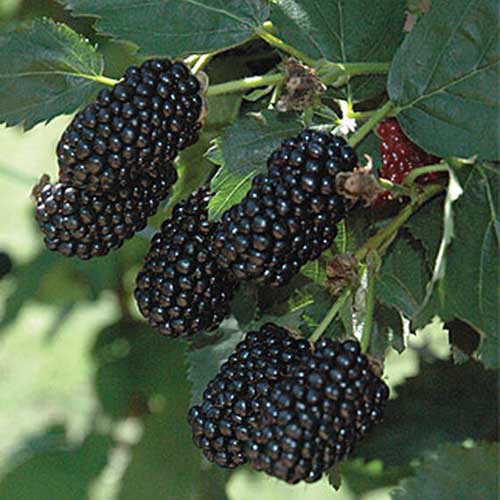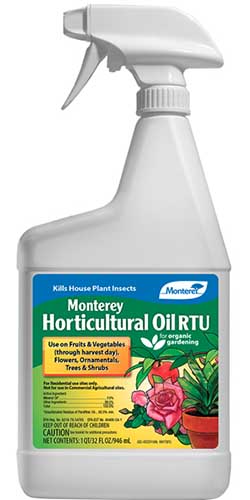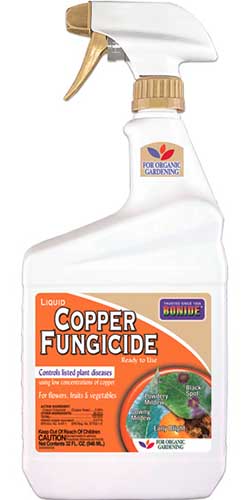Rubus fruticosus agg.
There’s nothing like choosing a plump, juicy-looking blackberry from the vines in your non-public yard and popping it into your mouth.
The tart, candy model of homegrown blackberries is unbeatable. Nonetheless, you might be questioning, how precisely do you develop these berries at residence?
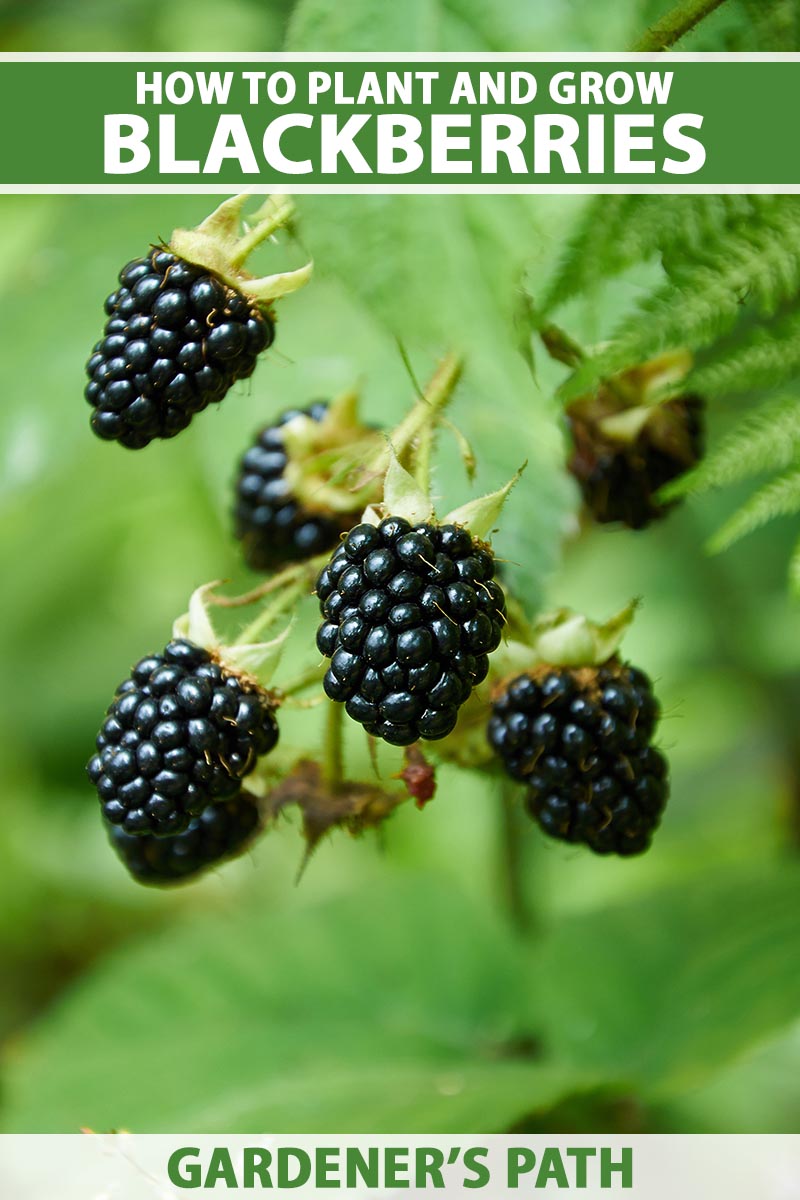

We hyperlink to distributors that will enable you to uncover related merchandise. In case you purchase from one amongst our hyperlinks, we could earn a worth.
In case you’re questioning whether or not or not or not you’d be succesful to develop huge berries like these you see contained in the retailer, or throughout the event that they’d be smaller, or how extended the engaging fruits have been spherical, you’ve come to the appropriate place.
On this knowledge, we’ll dive into the entire thing you’ve ever wished to review rising your non-public blackberries.
Correct proper right here’s what I’ll cowl:
What Are Blackberries?
Blackberries are members of the Rosaceae household, together with such good vegetation as raspberries, roses, and apple bushes.
Like intently associated raspberries, blackberries are brambles: they’re normally thorny, develop thick and tangly, and could be upright or sprawling.
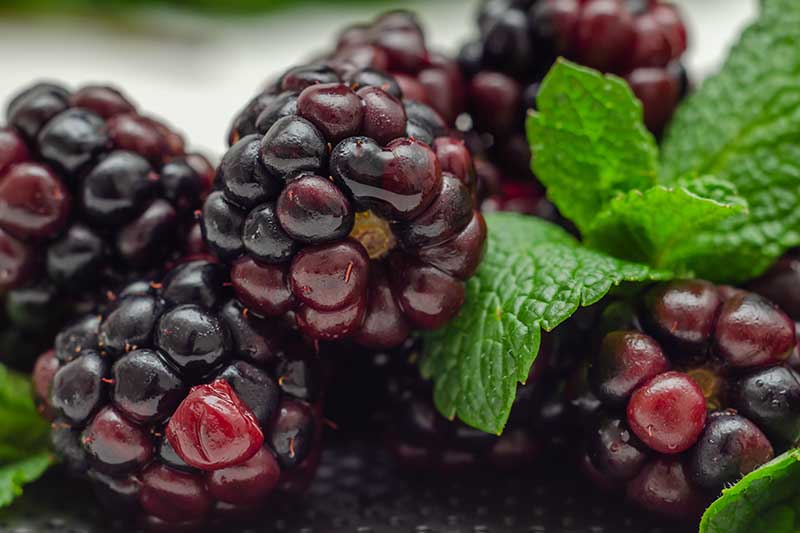

The fruits usually are normally not true berries in the least, nonetheless fairly, combination fruits made up of small spherical drupelets. Not like raspberries, blackberries shield their core intact when picked.
Blackberries are perennial vegetation that bear fruit on biennial canes. They develop new inexperienced stems, usually typically referred to as primocanes, yearly, and these usually bear leaves nonetheless not flowers on what are typically typically referred to as “floricane fruiting” vegetation.


Contained in the second yr, these primocanes develop to be floricanes. They flip woody, sprout leaves and new stems from lateral buds branching off the primary stem, and produce flowers on these lateral stems.
The flowers then develop to be these irresistibly juicy, sweet-tart berries. After this, the floricanes die.
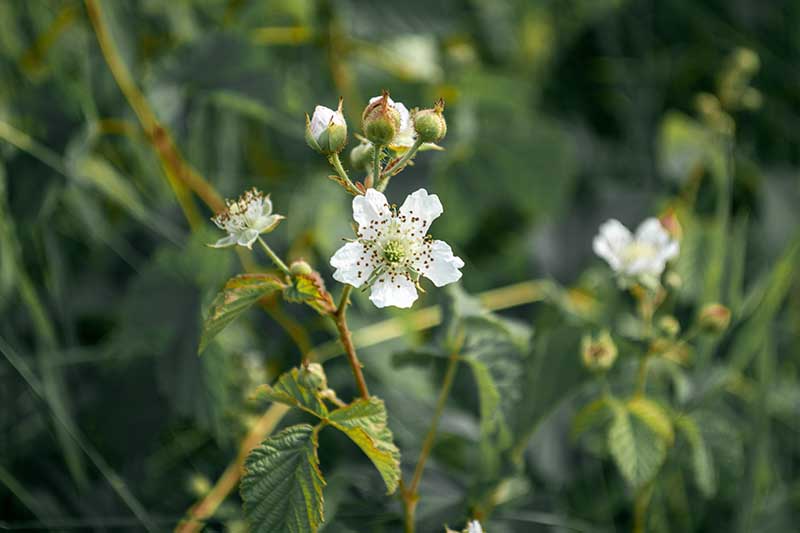

Blackberries are self-fertile, which suggests pollen from one plant can fertilize the same plant – there’s no must plant one totally different alternative shut by for cross-pollination capabilities.
Nonetheless these berries usually are normally not self-pollinating: they require bees and butterflies to assist change pollen from one flower to a particular.
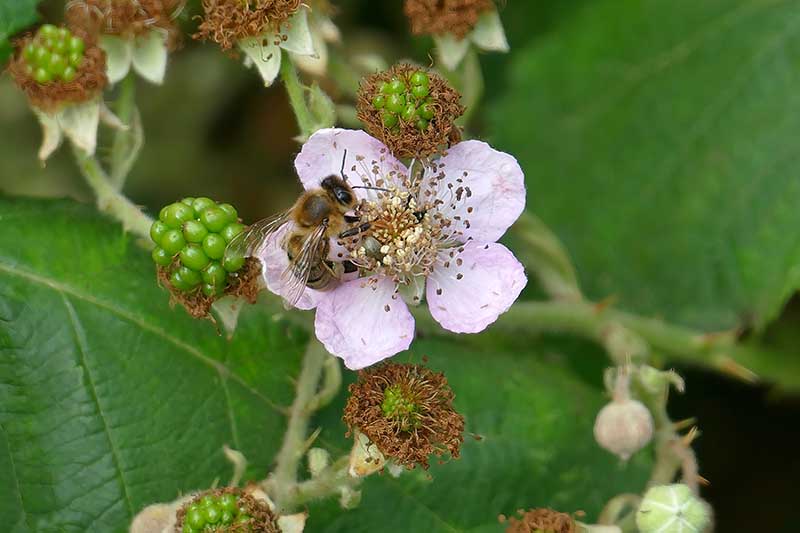

These fruits could be grown in USDA Hardiness Zones 4-9. Many sorts have prickles, nonetheless some have been bred to be thornless.
Although uncommon, a further moderen breakthrough in blackberry breeding, primocane-fruiting varieties, furthermore typically referred to as “fall-bearing” blackberries, bear a small crop the primary fall after being planted from a unadorned root, with a full crop following contained in the second yr.
Blackberries want loamy, well-draining soil with a pH of 5.5 to 7.0, and thrive in a full photograph voltaic location with six to eight hours of direct sunshine.
Their widespread excessive and unfold varies extensively, nonetheless normally, you’ll want to put every plant about three to 5 toes aside throughout the event you plan to develop just a few.
There are three utterly utterly totally different plant buildings referring to blackberries:
- Erect: upright bushes that don’t want help, are additional winter hardy than their semi-erect and trailing counterparts, and produce candy, massive berries.
- Semi-erect: bushes that require some help, are every thorny or thornless, and produce a much bigger quantity of berries than erect cultivars; berries are candy and tart.
- Trailing: vines require help, normally with a trellis; these are usually the least winter hardy of all nonetheless produce various juicy, candy berries.
Now, let’s dig into the 5 most notable species of blackberry. It’s important to notice that contained in the wild, species freely interbreed.
Furthermore, understand that the class of blackberries as a whole are typically typically referred to as Rubus fruticosus agg., with “agg.” being an abbreviation for combination.
The varied blackberry species are grouped this pattern for smart capabilities of taxonomy, and to tell apart them from utterly totally different Rubus fruits, paying homage to raspberries and dewberries.
This time interval doesn’t search the recommendation of with any specific botanically acknowledged species of blackberry.
Many subspecies, cultivars, and hybrids exist for every of the next species. They’ve furthermore been blended and crossed endlessly by plant breeders to create as we converse’s hottest varieties.
R. allegheniensis
Moreover referred to as the Allegheny or highbush blackberry, this erect species grows 5 to eight toes tall with a ramification of 5 toes.
It grows wild inside {the japanese} and central parts of North America, favoring open meadows, rocky forests, fields, and fencerows.
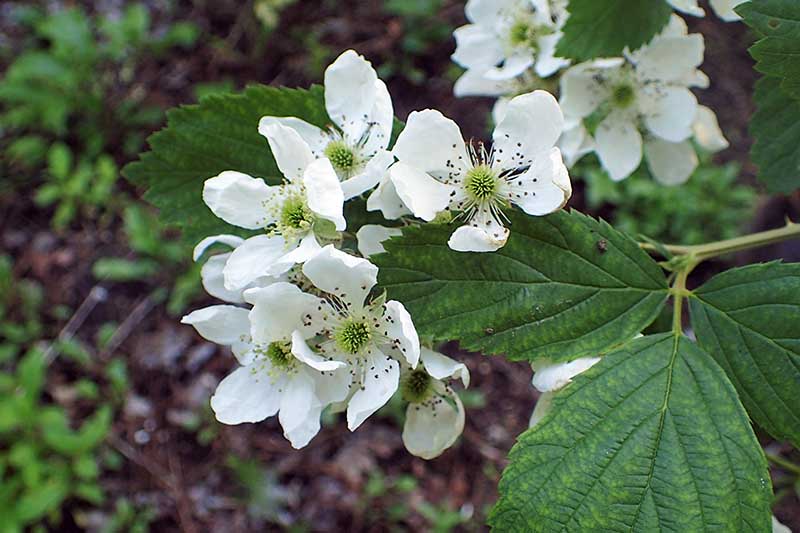

This species blooms with dainty white flowers which is more likely to be three-fourths of an inch in dimension, between April and June. R. allegheniensis bears fruit on floricanes from June to August, relying on the world.
The berries are candy and cylindrical, merely three quarters of an inch in dimension.
R. argutus
Native to {{the japanese}} and southern parts of america, from Maine to Illinois and Texas to Florida, semi-erect R. argutus furthermore goes by the set up sawtooth or tall blackberry, nevertheless it doesn’t develop fairly as tall as R. allegheniensis.
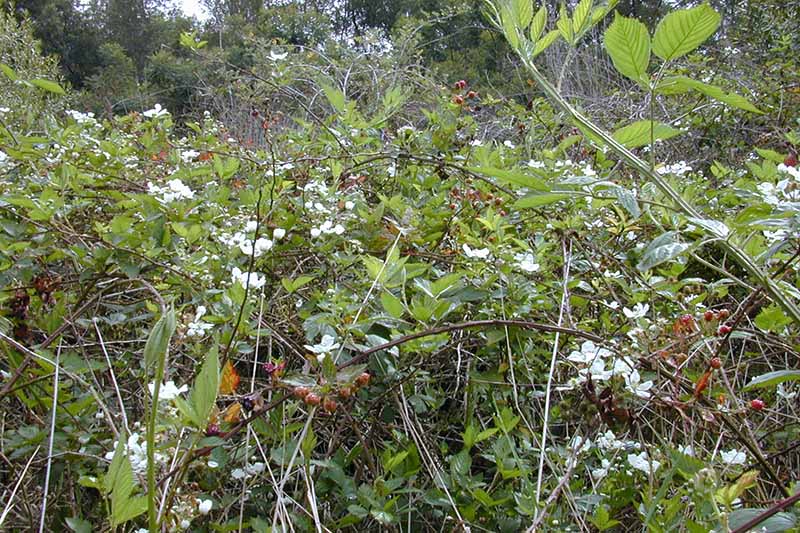

R. argutus reaches between two and 6 toes tall with the an identical unfold. The plant blooms contained in the late spring with white flowers which is more likely to be three-quarters to 1 inch in diameter, and bears fruit on floricanes throughout the summertime.
The berries kind tart and evenly candy, and are two-thirds of an inch extended.
R. armeniacus
Typically referred to as Armenian or Himalayan blackberry attributable to its native vary in northern Iran and Armenia, R. armeniacus has naturalized all world broad, together with in North America after botanist Luther Burbank launched it correct proper right here in 1885.
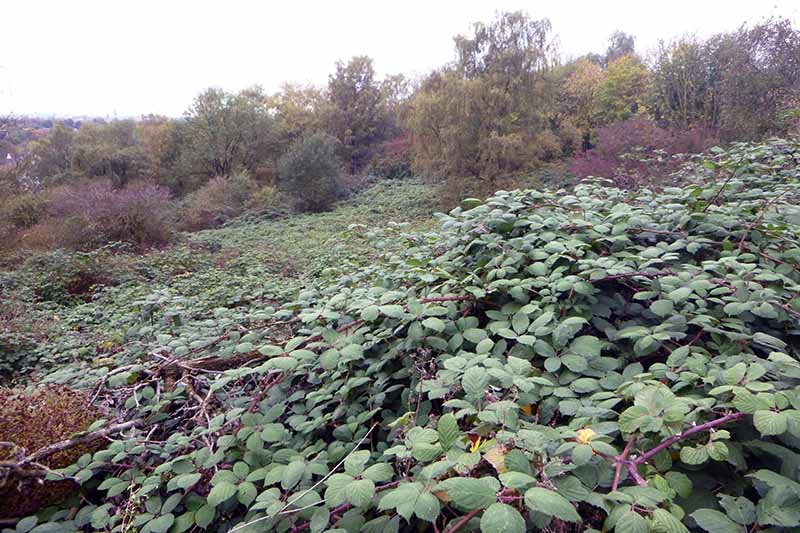

The semi-erect bushes develop as lots as 9 toes tall and will arch as soon as extra within the course of the underside, making a trailing impression.
R. armeniacus might be very prolific contained in the Pacific Northwest and Canada. Some give it some thought an invasive species attributable to its fast unfold, nonetheless its berries are a variety of of crucial and sweetest spherical.
This species blooms with white or pale pink flowers which is more likely to be three quarters to 1 inch in dimension, from late spring to early summer season season. Fruits develop and mature in mid to late summer season season and will attain as lots as one inch in dimension.
R. laciniatus
Furthermore typically referred to as cutleaf evergreen or evergreen blackberry, R. laciniatus is simple to tell aside from its counterparts attributable to its sharp-looking, deeply lobed leaves.
Regardless of the set up, this species is deciduous and has naturalized in various the western and japanese United States.
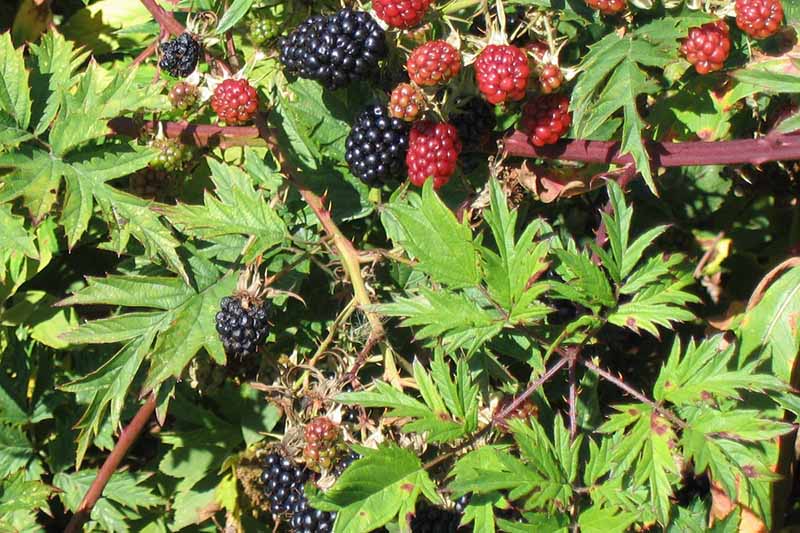

Contained in the Northeast and Pacific Northwest, it’s thought-about an invasive species, though it doesn’t unfold as readily as R. armeniacus. This species is native to someplace in Eurasia, nonetheless the precise location is unknown.
The upright nevertheless sprawling bushes can develop as lots as ten toes tall with the an identical unfold. The white flowers are three quarters of an inch extended, they usually bloom and bear fruit repeatedly between June and September.
The berries are cylindrical in kind and simply half an inch in dimension. R. laciniatus has been crossed with utterly totally different species to assist create fairly just a few sorts of enterprise blackberries.
R. ulmifolius
Native to North Africa and far of Western Europe, R. ulmifolius is normally typically referred to as the elm-leaf blackberry, a shrubby plant which is able to develop as lots as 15 toes tall with the an identical unfold.
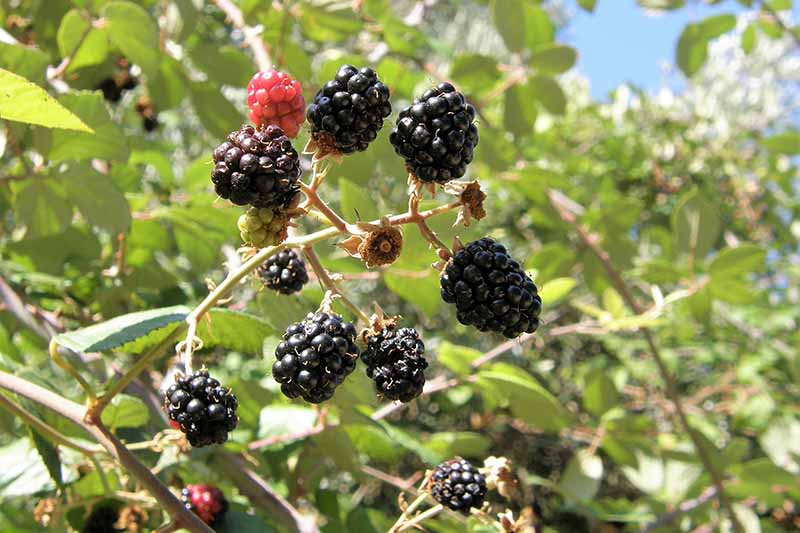

R. ulmifolius is erect when immature after which turns into semi-erect because of it grows taller and the canes arch within the course of the underside.
The flowers, which bloom from Might to July, are pink and 1 / 4 to half an inch in dimension. The oval-shaped, half-inch-long berries come between July and September.
R. ulmifolius has naturalized world in depth, together with contained in the Pacific Northwest.
R. ursinus
Native to British Columbia, California, Idaho, Montana, Oregon, and Washington, R. ursinus goes by many names, together with Pacific and California blackberry.
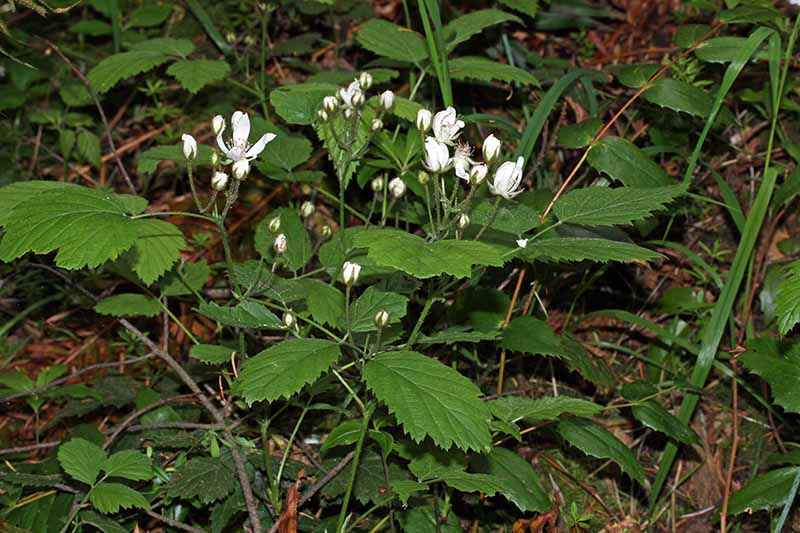

A trailing species, it grows merely two to 5 toes tall and spreads as lots as six toes.
The white flowers have narrower petals than the choice species talked about correct proper right here. The plant blooms and fashions fruit repeatedly between March and August.
The cylindrical berries are anyplace from half to 1 inch in dimension.
Cultivation and Historic earlier
These scrumptious drupelet fruits have extended been in kind world in depth. As you research above, their native vary varies extensively.
They’ve probably been spherical for not less than 2,500 years; the Haraldskær Girl, a well-studied toilet physique present in Denmark in 1835, had eaten millet and blackberries shortly ahead of her lack of life in 490 BC.
Scientists found this barely nauseating information all by an post-mortem on her well-preserved physique in 2000.
Lest our kind for blackberries get ruined ceaselessly, let’s swap on shortly and see what English herbalist Thomas Gerard wished to say about these fruits in his 1597 e information, Gerard’s Herball:
“The fruit or berry is like that of the Mulberry, first crimson, blacke when it’s ripe, in kind betweene; candy and soure, very delicate, and full of grains: the inspiration creepeth, and sendeth forth correct proper right here and there youthful springs.”
In case your eyes are ever “hanging out,” concern not, for Gerard says this plant can soothe such a illness: “The yong buds or tender tops of the Bramble bush, the floures, the leaves, and the unripe fruit, being chewed, protect all strategy of bleedings. They heale the eies that dangle spherical.”
I want to counsel you see an exact physician if this ever turns into an issue, in any case, nonetheless isn’t it fascinating to get a peek into the maladies and coverings of the sixteenth century?
And throughout the event you’re turning into bored collectively along with your bottle of lotion, your bar cleaning cleansing cleaning soap, or your toothpaste, you may frequently attempt Gerard’s all-purpose combine: “The leaves of the Bramble boyled in water, with honey, allum, and only a bit white wine added thereto, make a most great lotion or washing water, and the same decoction fastneth the enamel.”
Indigenous peoples in your complete native ranges the place blackberries develop have extended beloved incorporating the berries into their delicacies. Furthermore they use the leaves for tea, and the berries make a beautiful reddish purple dye.
Blackberry Plant Propagation
The very best methodology to get began rising your non-public blackberries is to purchase a unadorned root or a youthful plant from a nursery and put it contained in the flooring.
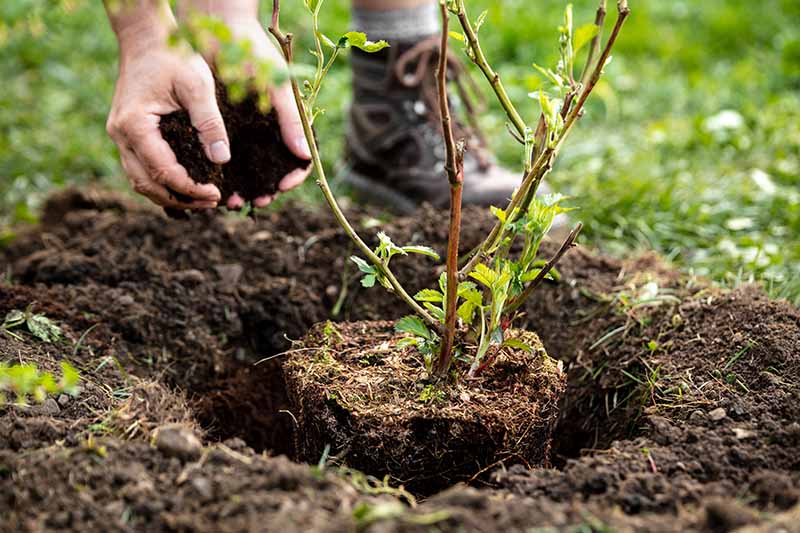

Or, if you have already got a plant at residence or know good pal who’d gladly spare a chopping, you may propagate blackberries by means of stem cuttings or tip layering.
It’s doable to develop these berries from seed, nevertheless it’s unusual to hunt out seeds and it’s merely simpler to propagate utilizing a particular strategy.
We’ll cowl the 4 principal transplant and propagation strategies beneath:
Naked Root
Most dormant naked roots are bought in late winter or early spring, which is the perfect time to plant them.
You’ll need to plant your naked root as shortly as doable after receiving it.
The second you get it contained in the mail or ship it residence from a nursery, open the bundle and punctiliously place your full root ball inside a bucket full of room-temperature water to assist restore moisture.
Let it soak for as lots as two hours when you set collectively the planting internet web page.
Dig a trench that’s about two to a few inches deep and eight inches in depth, which is able to give the roots quite a lot of house to stretch. Cane berries have shallow root methods, so that you just simply don’t must dig a deep trench.
Add a pair handfuls of well-rotted manure or compost to the planting internet web page to assist make the soil richer.
Place your dormant naked root contained throughout the shallow trench and fan out the roots. This might assist shield them from getting too knotted collectively and may promote airflow inside the premise system because of it grows and establishes contained in the soil.
Backfill the outlet with soil and water absolutely.
Whereas it’s nonetheless dormant, solely water the plant a variety of cases per week, or when the soil is dry two inches down.
You need to begin seeing new, inexperienced lateral stems and leaves inside 4 weeks. For the time being, improve watering to at any time when the perfect inch of soil feels dry.
From Cuttings
Propagating new blackberry bushes from cuttings is a pleasurable prepare to do with the youngest gardeners in your life due to it’s straightforward and straightforward.
First, you’ll want a prepared good pal with a thriving plant, a pointy pair of pruners, and some four-inch pots filled with potting combine. You may also need to positioned on a long-sleeved shirt and gardening gloves to guard your arms from the prickles.
You may take cuttings at any time between spring and fall, when the plant is actively rising.
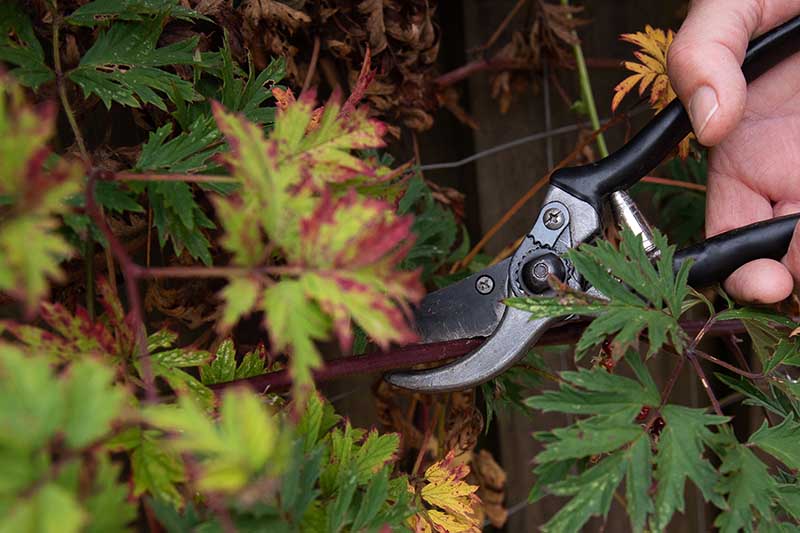

Uncover a dimension of primocane, which is that inexperienced first-year progress with out flowers or fruits, and reduce a four- to six-inch part of the cane.
You’ll need to take a minimal of two to a few cuttings to assist guarantee your prospects of success.
Take away the leaves from the underside inch or two of every chopping, and bury each about two inches deep contained in the potting combine. As shortly as every chopping has a house, water slowly, till water runs out the underside of the pot.
When new leaves start to develop, you’ll know your cuttings have rooted. This may occur inside about 4 to 6 weeks from the time you take the cuttings.
After they’ve rooted, you may transplant them into eight-inch pots in potting soil amended with well-rotted compost or manure, or with 20-20-20 NPK fertilizer in accordance with bundle directions.
Tip Rooting
Contained in the wild, these brambles merely unfold by means of underground rhizomes and by pure tip layering, or tip rooting. Tip rooting occurs when the vine of a trailing or arching cane berry touches the underside.
The vine grows roots the place it touches the earth, much like a strawberry sends out runners to root new little vegetation correct proper right here and there all by means of a berry patch.
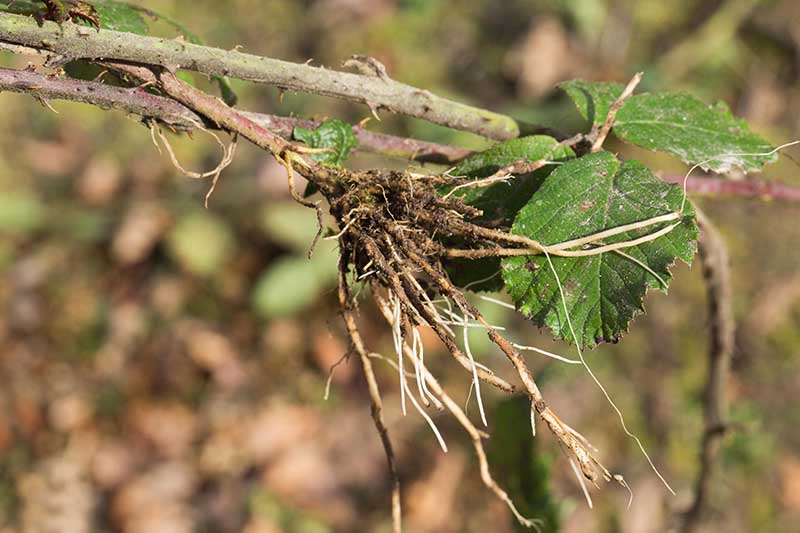

To imitate pure tip layering, put collectively a four-inch container with potting combine and punctiliously bend a vine or two from a primocane till the tip of it touches the combination.
Cowl about two inches of the tip with soil. If it gained’t protect put, place a small stone on extreme of the vine to maintain up it in place.
Water the buried tip about as shortly as per week, or additional typically if the soil dries out one inch down.
Inside a pair weeks, it’s best to be succesful to take away the rock and spot that the cane is staying in place. It’s obtained new roots!
Cut back the cane away from its mom plant just a few foot away from the place it rooted contained in the pot. Now you’ve gotten gotten a plant that you just’d be succesful to provide to an ideal pal or put contained in the flooring. You will want to transplant it a minimal of three to 5 toes away from the mother or father, as described beneath.
Transplants
For this straightforward strategy, all you want is a mannequin new, dwell plant and a full-sun location to place it in.
Dig a spot as deep and in depth because the inspiration ball of the dwell plant and add a pair handfuls of well-rotted manure or compost to the outlet. Mix this with the prevailing soil.
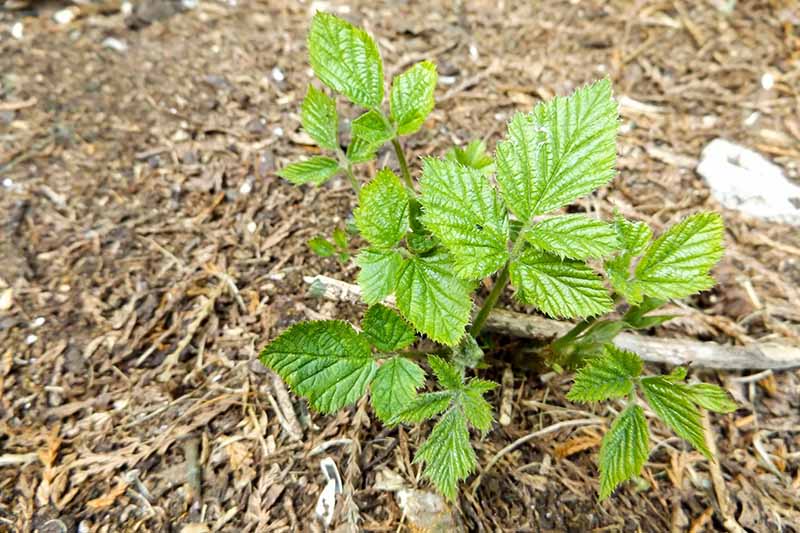

Fastidiously take away your plant from its container and set it in its new residence. Backfill with soil and water absolutely.
Water as quickly as further at any time when the perfect inch of soil dries out.
The way in which by which to Develop Blackberries
Each spring, you’ll need to give established vegetation one dose of 20-20-20 NPK fertilizer in accordance with bundle directions. Be taught our knowledge to fertilizing blackberries for further knowledge on feeding your vegetation.
Your vegetation will want water one or two occasions per week contained in the absence of rain, or at any time when the perfect inch of soil dries out.
You’ll uncover that when fruits start to kind, the plant takes up additional water than frequent, and as well as you’ll want to elongate watering accordingly.
Make sure that to avoid overhead watering as fairly a bit as doable. This might assist shield your valued vegetation from falling sufferer to totally different fungal sicknesses.
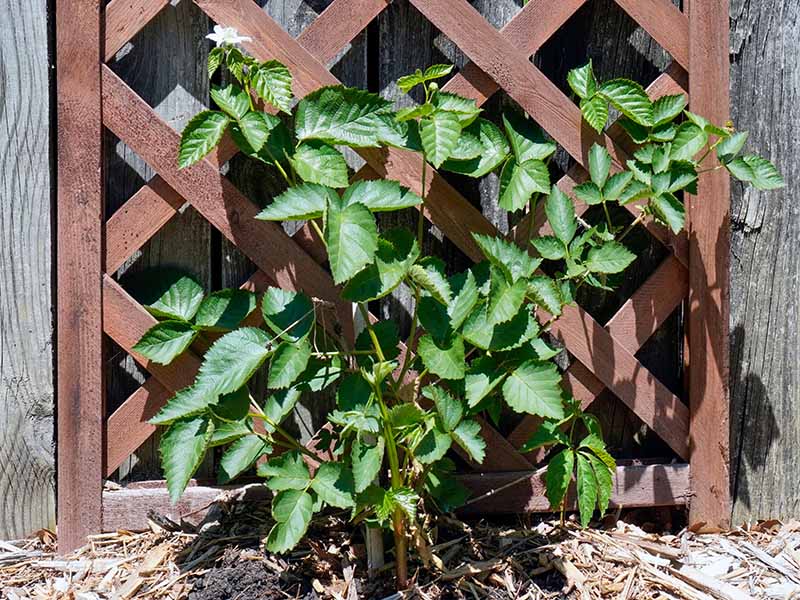

Relying on whether or not or not or not you’ve planted erect, semi-erect, or trailing varieties, it’s potential you will have to develop your vines within the course of a trellis for help.
These of us who dwell in colder areas ought to mulch with dark-colored provides to protect heat and moisture.
These of you who dwell in hotter climes can mulch with light-colored provides to deflect a bit of warmth from the photograph voltaic and shield the roots cool and moist.
Contained in the winter, cowl your full plant with straw. In case you dwell in an space the place it snows, the snow will cowl the straw and make a unbelievable insulation within the course of brutally chilly native climate.
Rising Methods
- Water a variety of cases per week, or at any time when the perfect inch of soil dries out.
- Mulch to assist present even moisture and shield the plant cool or heat, relying on the place you reside.
- Cowl with straw contained in the winter when dormant.
- In case you are low on house, attempt rising your berries in containers.
Pruning and Repairs
Blackberries require solely a bit little little bit of trimming to maintain up them healthful and absolutely comfortable.
Every spring, you’ll must prune the central primocanes of every plant to a few or 4 toes in excessive.
This might encourage the plant to focus its power on rising laterals. Nonetheless you’ll must trim these as appropriately, as soon as extra to about twelve inches in dimension.
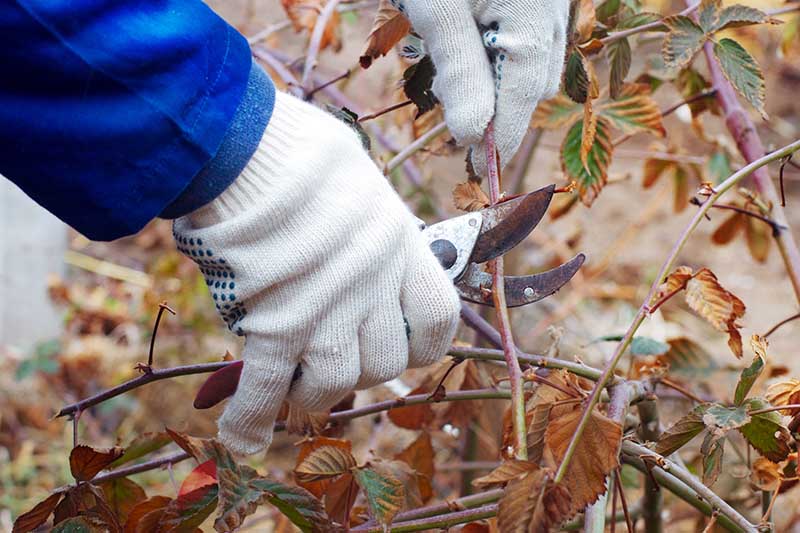

Because of the plant goes dormant and temperatures dip in late fall or early winter, it’ll be pruning time as quickly as further.
Cut back the spent floricanes correct proper all the way down to the underside to get them out of among the finest methods. Trim the central primocanes to a few to 4 toes as quickly as further, and the laterals as soon as extra to about 12 to fifteen inches.
Be taught additional about pruning your blackberries correct proper right here.
Blackberry Cultivars to Choose
There are dozens of cultivars to pick from referring to blackberries. Listed beneath are just a few of our favorites to kickstart your journey into rising these tart fruits.
Arapaho
Would you desire a thornless, erect cultivar that produces a sturdy crop of candy, one- to two-inch-long berries?
Look no further than ‘Arapaho,’ a hottest alternative cultivated by breeders on the Faculty of Arkansas contained in the early Nineties.
‘Arapaho’ is hardy in Zones 5 by means of 7, reaches a mature excessive of 4 to 6 toes, and spreads three to 4 toes.
Even higher, this cultivar blooms with pink and white flowers in mid spring and produces fruits that ripen in mid-June. It’s one amongst many earliest-maturing blackberry cultivars available on the market.
Begin your berry patch off sturdy with a pack of three naked root vegetation, available on the market from Nature Hills Nursery.
Darrow
In case you just like the thought of a trellis wound by means of with blackberry vines, ‘Darrow’ is the conventional, trailing cultivar for you.
This disease-resistant cultivar grows as lots as three or 4 toes in excessive and width, and climbs a trellis fantastically.
It’s hardy in Zones 5 by means of 8. The floricanes bloom with white flowers in April and early Might and produce tart, evenly candy berries – which might be acknowledged to kind a whole lot like these you’d uncover contained in the wild – in June, July, and August.
The extended choosing season can have you ever ever forgiving the thorns on ‘Darrow.’ The berries are about three quarters of an inch to 1 inch in dimension.
Begin your berry-growing journey with naked root vegetation from Nature Hills Nursery.
Prime-Ark Freedom
In case you’re impatient, like I’m, this primocane-fruiting cultivar is an ideal choose.
Bred and launched to most individuals by plant breeders on the Agricultural Experiment Station on the Faculty of Arkansas in 2013, ‘Prime-Ark Freedom’ is an erect, thornless alternative that gives you a crop inside the primary yr.
Even higher, ‘Prime-Ark Freedom’ is pest and illness resistant. Hardy in Zones 6 by means of 8, this cultivar grows as lots as 5 or 6 toes in excessive and unfold.
It blooms with pink and white flowers in early to mid spring. The heavy, one- to two-inch-long berries ripen in July or August for primocane-borne fruits, and June for floricane-borne fruits.
Which suggests that contained in the second yr, you’ll get two crops of berries: one in early summer season season and one in late summer season season!
Uncover naked roots or dwell vegetation in your blackberry patch available on the market from Burpee.
Managing Pests and Illness
Blackberries can fall prey to quite a lot of pests and sicknesses, nonetheless by avoiding overhead watering, utilizing solely healthful and disease-free inventory, and cleansing gardening gadgets ahead of utilizing them to plant your berries, you’ll avoid numerous factors.
Pest and illness resistant cultivars abound, too, further serving to to maintain up your plant healthful. Nonetheless we’ll take a fast check out a variety of of the extra widespread elements to look at for.
Pests
You probably gained’t expertise an excessive amount of drama with pests. Whereas blackberries can typically endure from aphid infestations, these don’t usually tend to occur typically and could be merely handled with insecticidal cleaning cleansing cleaning soap or neem oil spray.
Redberry mites (Acalitus essigi) are a peskier draw again, as they’re microscopic. The one methodology to know that they’ve infested a plant is that some drupelets definitely not mature to a black colour like they need to, although utterly totally different drupelets do.
Take away the affected fruits and spray the remainder of the plant with a horticultural miticide oil, like this one by Monterey, available on the market from Arbico Organics.
Even a variety of of the extra notable pests, like noticed wing drosophila (Drosophila suzukii), which looks as if a pale orange-yellow fruit fly, and Japanese beetles (Popillia japonica) don’t set off lasting damage if caught and managed early.
Seen wing drosophila infests specific particular person berries, depositing white larvae inside. Ew! To check for these, drop a berry in heat saltwater.
After half an hour, affirm the bottom of the water. In case you see small white maggots floating on the perfect, you’ve gotten gotten an infestation.
In case you uncover an infested berry all by the saltwater try, you’ll furthermore need to affirm a berry from every lateral division to see if it’s contaminated with maggots. If that’s the case, take away and destroy the affected division.
Japanese beetles skeletonize the leaves, together with consuming flowers and ripe fruits. They’re about half an inch extended with copper wings and inexperienced our our our bodies.
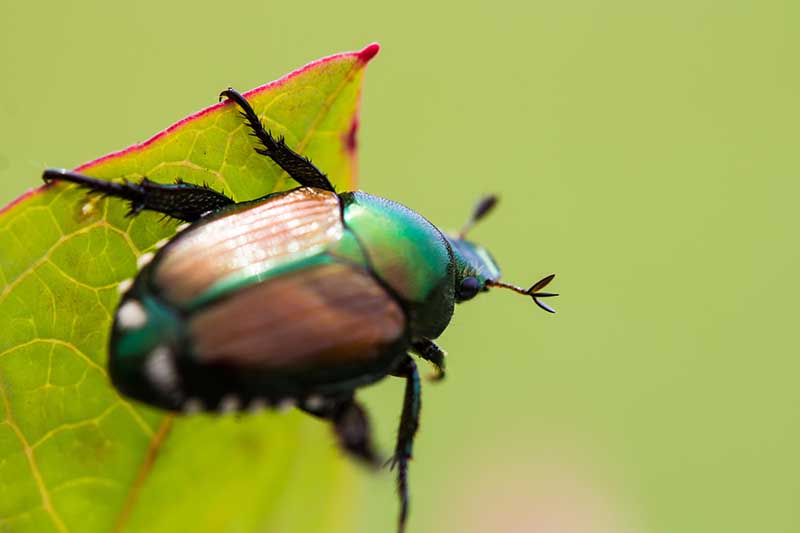

On the first signal of Japanese beetle damage, take away affected foliage and spray your full plant with PyGanic, a botanical pesticide made with pyrethrum.
Pyrethrum is extracted from daisies and does wonders to take away beetles.
PyGanic is available on the market from Arbico Organics.
Illness
One widespread illness is anthracnose, which is attributable to the fungus Elsinoe veneta and ends in whitish-gray lesions that develop on youthful, actively rising canes and leaves.
An an an an infection can even set off cane lack of life, leaf drop, and low yields.
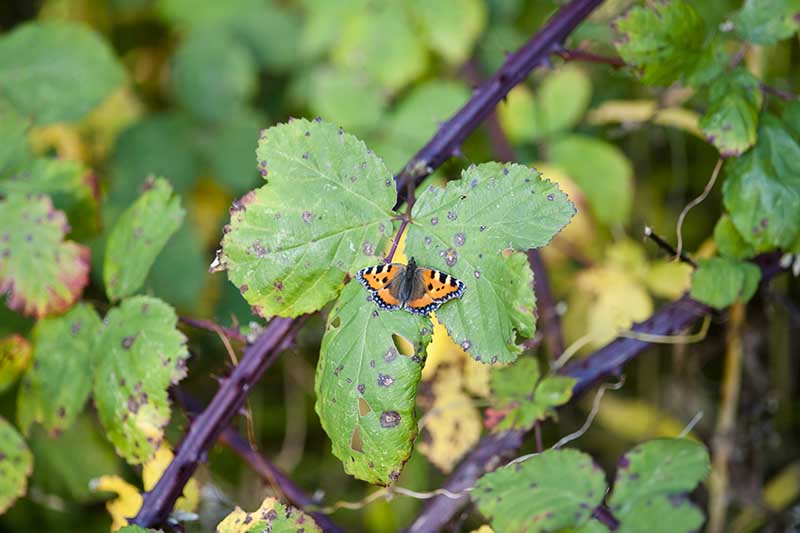

Avoiding overhead watering goes a wonderful distance within the course of stopping this moisture-loving fungal illness.
In case you uncover indicators of anthracnose in your vegetation, take away affected canes and spray the plant with a copper fungicide, like this one from Bonide that’s available on the market by means of Arbico Organics, in accordance with bundle directions.
One totally different plague which may impression your vegetation is orange rust, attributable to the fungus Gymnoconia peckiana. In new progress, orange rust manifests as weak shoots with pale inexperienced or yellow leaves.
Inside just a few weeks, orange pustules kind on the stems and leaves.
In case it’s possible you’ll arrange orange rust and take away and burn your full affected plant ahead of the pustules burst open, releasing spores into the wind to contaminate your utterly totally different brambles, you’re in luck.
Orange rust impacts a plant from the inspiration system on up, and whereas it gained’t kill a plant, it’ll stop fruit from forming. There’s no diploma in holding rust-infected cane berries spherical.
Since wild blackberries are additional prone to those sicknesses, it’s in your finest pursuits in case you are rising a cultivated crop in your yard to uproot and destroy any shut by wild Rubus vegetation, together with raspberries and dewberries, to assist stop the unfold of illness.
Completely totally different sicknesses that impression these cane berries are crown gall, witches’-broom fungus, and algal spot.
Harvesting and Preserving Blackberries
Harvesting blackberries is the one a part of all of the rising expertise.
All it’s important to do is wait till the berries have turned from crimson to deep purplish black, get a pair of gloves throughout the event you’re rising a prickly alternative, and head into the yard with a bucket.
You may choose them at any time, nonetheless early morning is good because of the day’s warmth hasn’t had a chance to melt or stress out the plump berries.
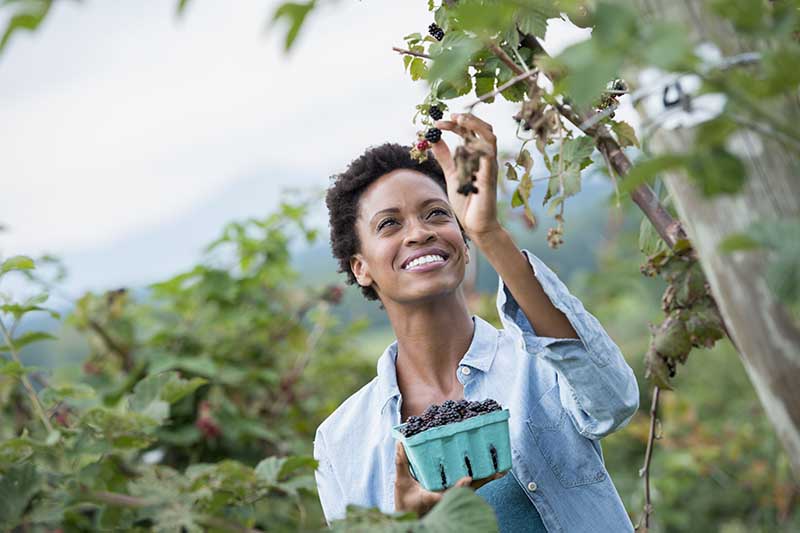

Pull your complete ripe blackberries that you just’d be succesful to off the vine and allow them to plunk into your bucket. And think about to pop just a few into your mouth, too!
In case you don’t use your harvest instantly, chorus from washing the blackberries.
Retailer them contained in the fridge in a shallow container coated with plastic wrap punctured with two or three holes. Eat them inside three to 6 days.
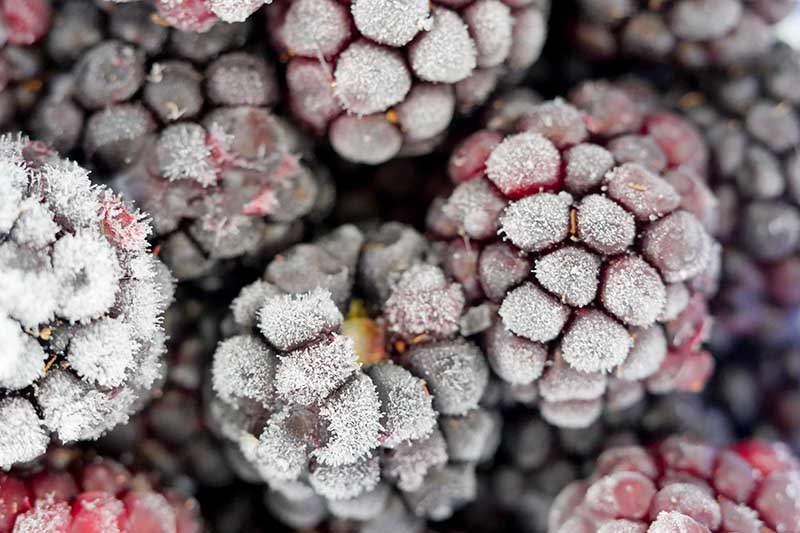

For an extended storage time, you may freeze your blackberries. Gently wash them in cool water, pat them dry with paper towels, and unfold them on a baking sheet in a single layer.
Put them contained in the freezer for numerous hours. As shortly as they’re frozen, change the berries correct proper right into a ziptop bag and put it as soon as extra contained in the freezer.
Frozen berries will closing for as lots as a yr!
Recipes and Cooking Concepts
There’s actually no prohibit to what you may dream up with a homegrown trendy or frozen harvest of blackberries. Toss them correct proper right into a smoothie or make them into jam.
Or, throughout the event you’re like me and want to bake, make these scrumptious scones from our sister internet web page, Foodal.
There’s nothing higher than one amongst these scones paired with a cup of espresso on a brisk spring morning.
For dinner, invite your mates over and serve these refreshing blackberry-lemon cocktails, furthermore from Foodal.
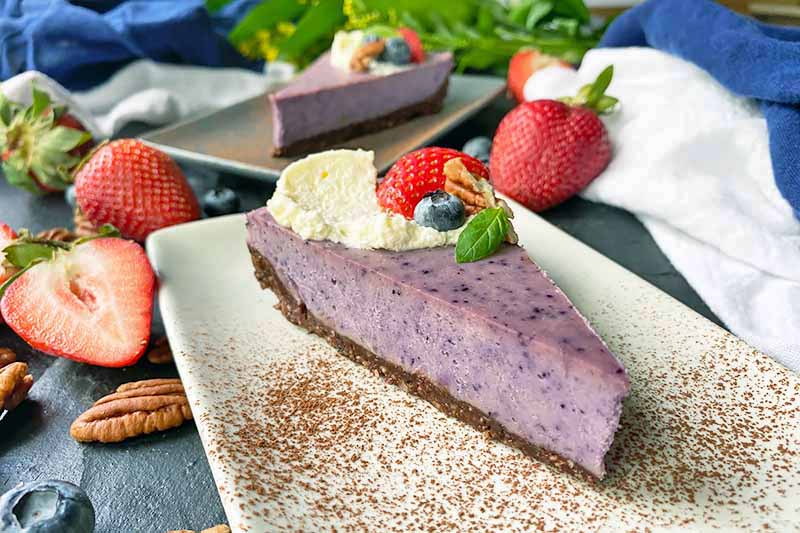

At dessert, please your gluten and dairy-free associates with this uncooked berry cream pie from Foodal.
And it’s possible you’ll frequently do the classics, too: cobblers, crisps, pies, parfaits, and no matter fits your kind buds. Regardless of the methodology you eat your blackberries, every chew is more likely to be a reward since you grew them your self.
Fast Reference Rising Data
| Plant Variety: | Perennial berry | Tolerance: | Frost |
| Native to: | Eurasia, Europe, North Africa, North America | Repairs: | Medium |
| Hardiness (USDA Zone): | 4-9 | Soil Variety: | Unfastened and organically wealthy |
| Season: | Spring, summer season season | Soil pH: | 5.5-7.0 |
| Publicity: | Full photograph voltaic | Soil Drainage: | Correctly-draining |
| Time to Maturity: | 1 years | Companion Planting: | Lemon balm, mint, peas, tansy |
| Spacing: | 3-5 toes | Keep away from Planting With: | Eggplant, peppers, potatoes, raspberries |
| Planting Depth: | 2 inches, depends upon form of propagation | Order: | Rosales |
| Excessive: | 3-10+ toes | Household: | Rosaceae |
| Unfold: | 3-10+ toes | Genus: | Rubus |
| Water Wants: | Widespread | Species: | Allegheniensis, argutus, armeniacus, fruticosus agg., laciniatus, ulmifolius, ursinus |
| Frequent Pests: | Aphids, Japanese beetles, redberry mites, noticed wing drosophila | Frequent Illnesses: | Algal spot, anthracnose, crown gall, orange rust, witches’ broom fungus |
Blackberry Bliss
Congratulations! You’re now geared up with all the knowledge it is advisable go forth and plant the blackberry patch of your needs.
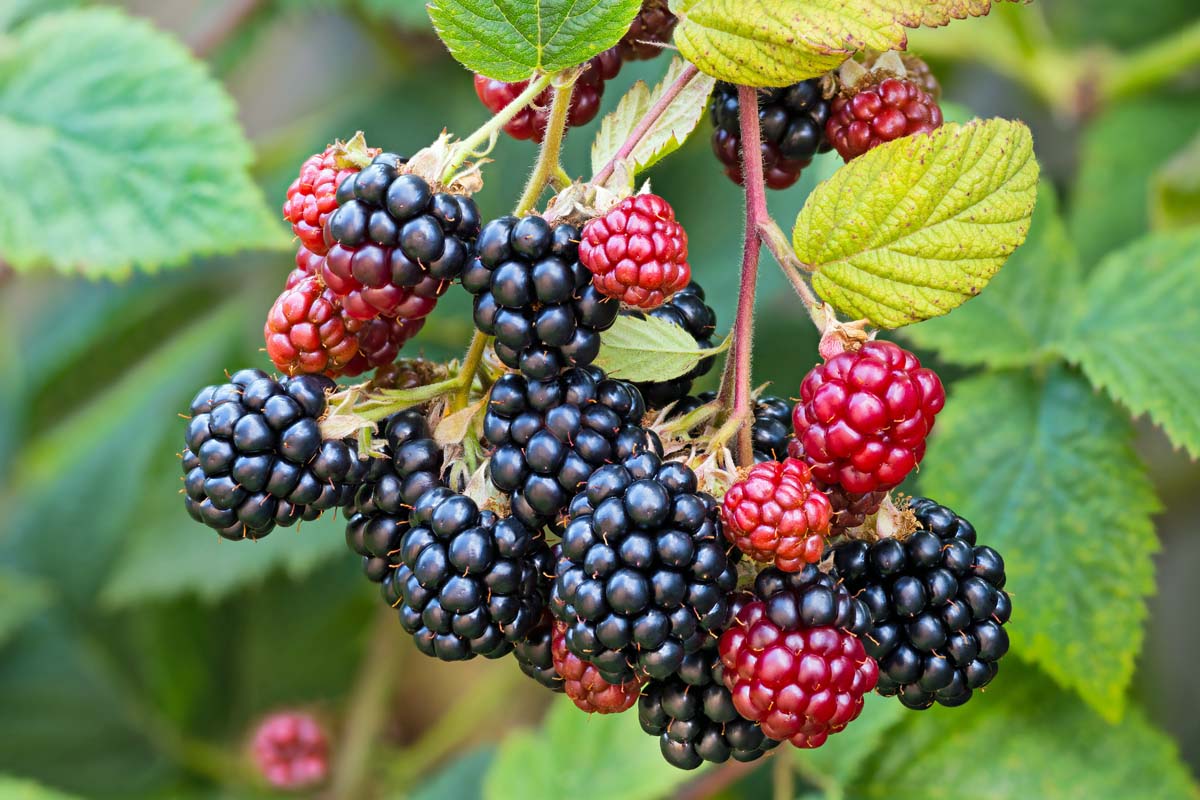

Nonetheless throughout the event you run into any elements, or have questions or tales to share, drop us a phrase contained in the recommendations half beneath. We wish to take heed to from you!
And contained in the meantime, for additional information on rising tasty berries in your yard, try these guides subsequent:

